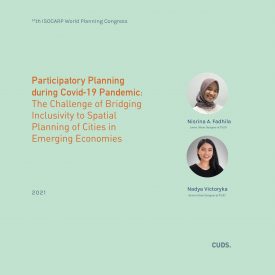
Aquaculture: The Thread of the Emerging Resiliency of Coastal Area in Indramayu
- Location
- Client
- Type
- Size
- Awards
Author: Assy Saffa Sakinah, Dionisius Briananto, Riardy Sulaiman
Presented in: 57th ISOCARP World Planning Congress
Year: 2021
Projected as the future Minapolitan area of West Java by Indonesia’s Ministry of Marine Affairs and Fisheries, Indramayu Regency possesses an abundance of coastal resources such as fisheries, mangroves & aquaculture. Yet among 309 villages in Indramayu, 46 are stated to be underdeveloped in 2019, making Indramayu Regency the lowest five among West Java in its Human Development Index. These underdeveloped villages are mostly housing families whose daily earnings are solely based on agriculture or/and fisheries activities located in the coastal part of Indramayu. The critical urgency of economic resilience supported by these natural resources is highlighted by The Spatial and Regional Planning of Indramayu Regency 2011-2031, stating Indramayu as the Regency Strategic Area in order to anchor further development agenda that will secure the wellbeing of its people. This study investigates possibilities in integrating the use of space and design of everyday infrastructure (specifically aquacultures) through sustainable coastal development to serve better resiliency provisions for the local economy and disaster mitigation as an anticipative response to the abrasion risk exposed to coastal Indramayu. The research will be carried out through qualitative and exploratory study starting with the case study done in Karangsong Village as the foundation that will be followed up by an analytical framework evaluating schemes of urban aquaculture facets explored by Grit Buergow in 2014. The explorative evaluation will revolve around the resiliency impacts of the water-living culture, water-farming culture, and water-wellbeing culture as the Water Sensitive Urban Design (WSUD) approach to review the readiness of Karangsong Village to adopt the mentioned coastal development. The results should assist stakeholders in regulating urban planning scenarios that enhance resiliency and the circular system of aquaculture cultivation in those underdeveloped villages along with the involvement of communities, which many of whom struggle to maintain reasonable livelihoods. The formulated urban planning scenario will be generally applicable up to the extent of both statutory planning (Building and Environmental Planning) and non-statutory planning (Masterplan) as long as collaborative and participatory approaches are conducted with the affiliated stakeholders.
Access the full paper here



